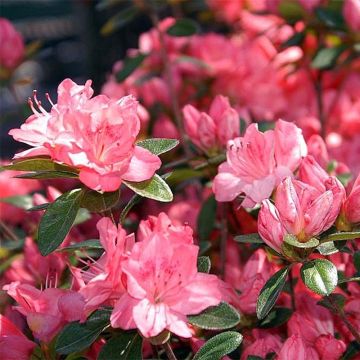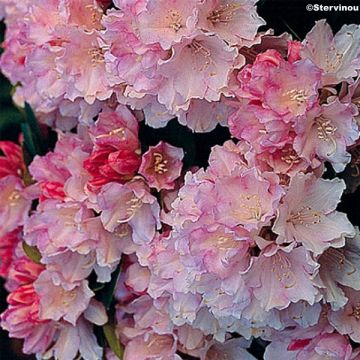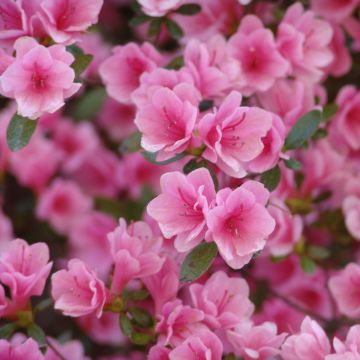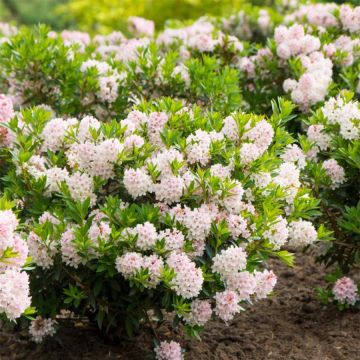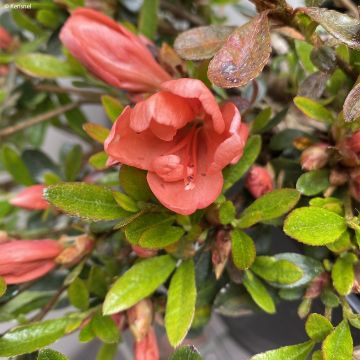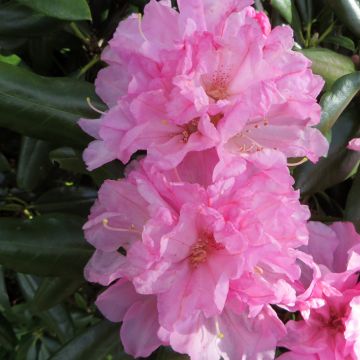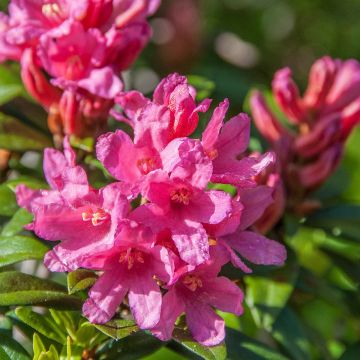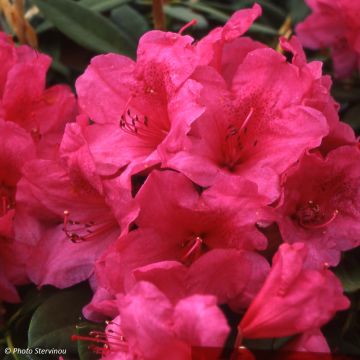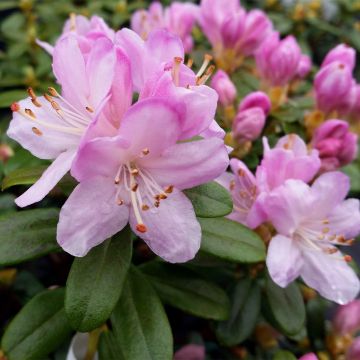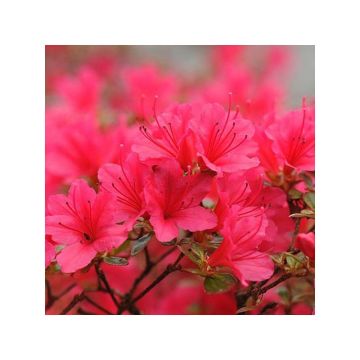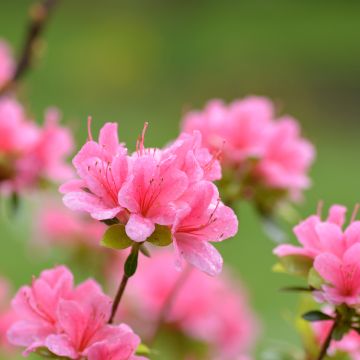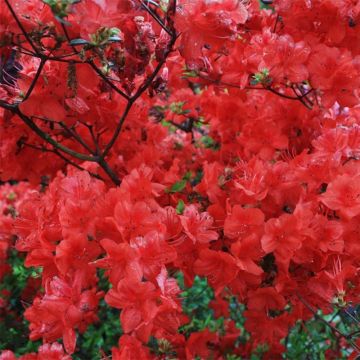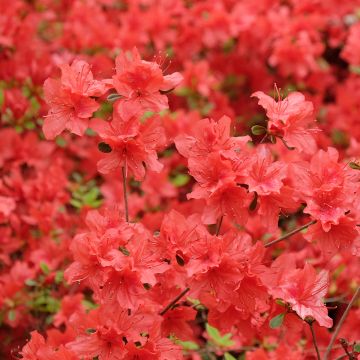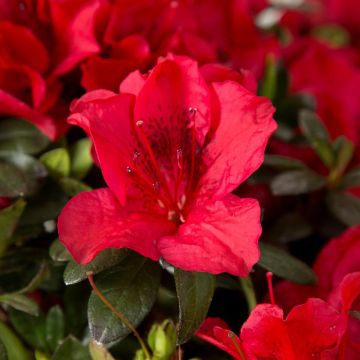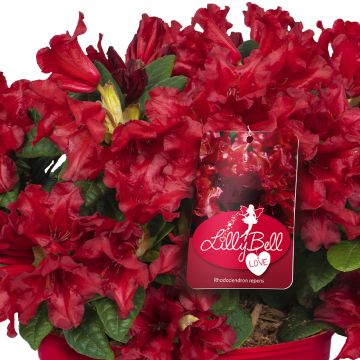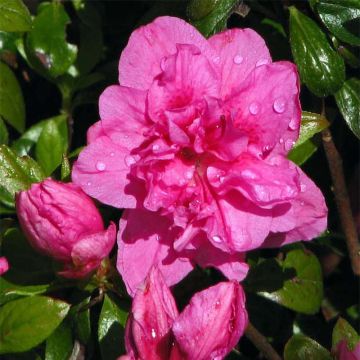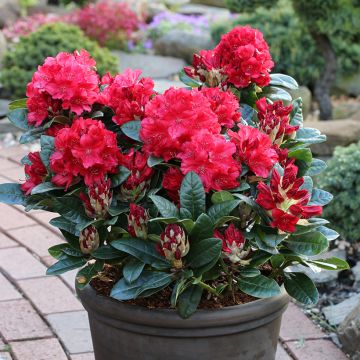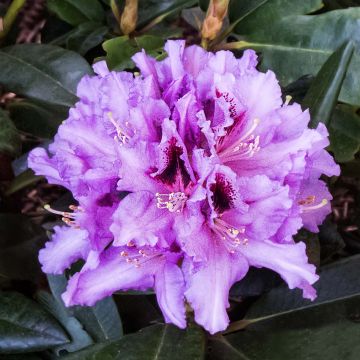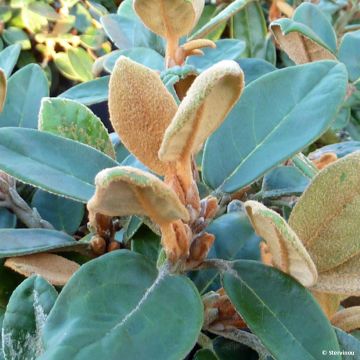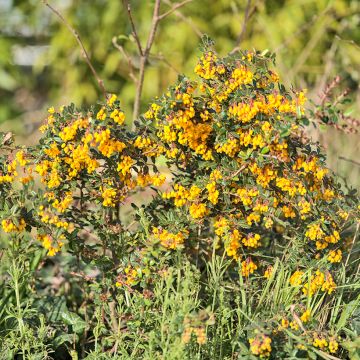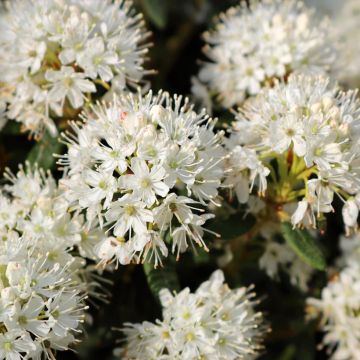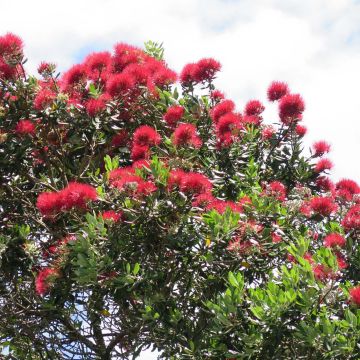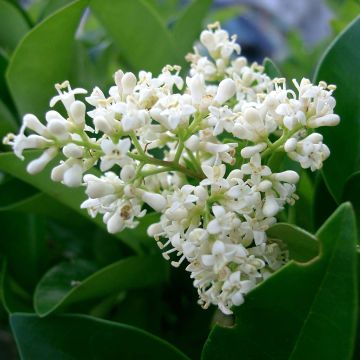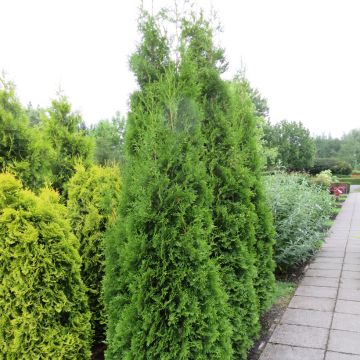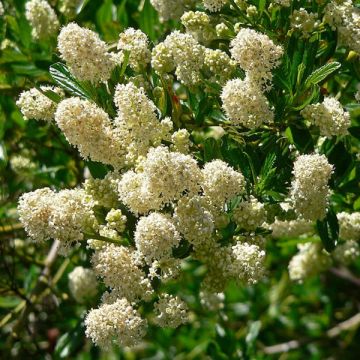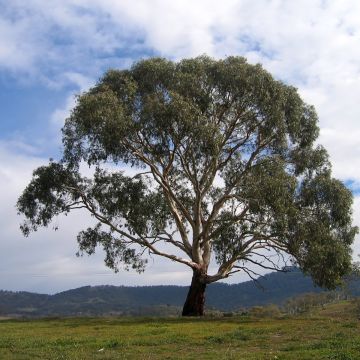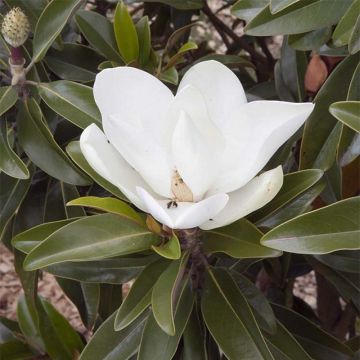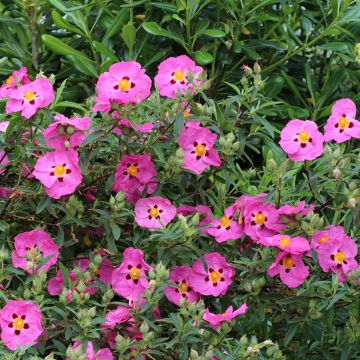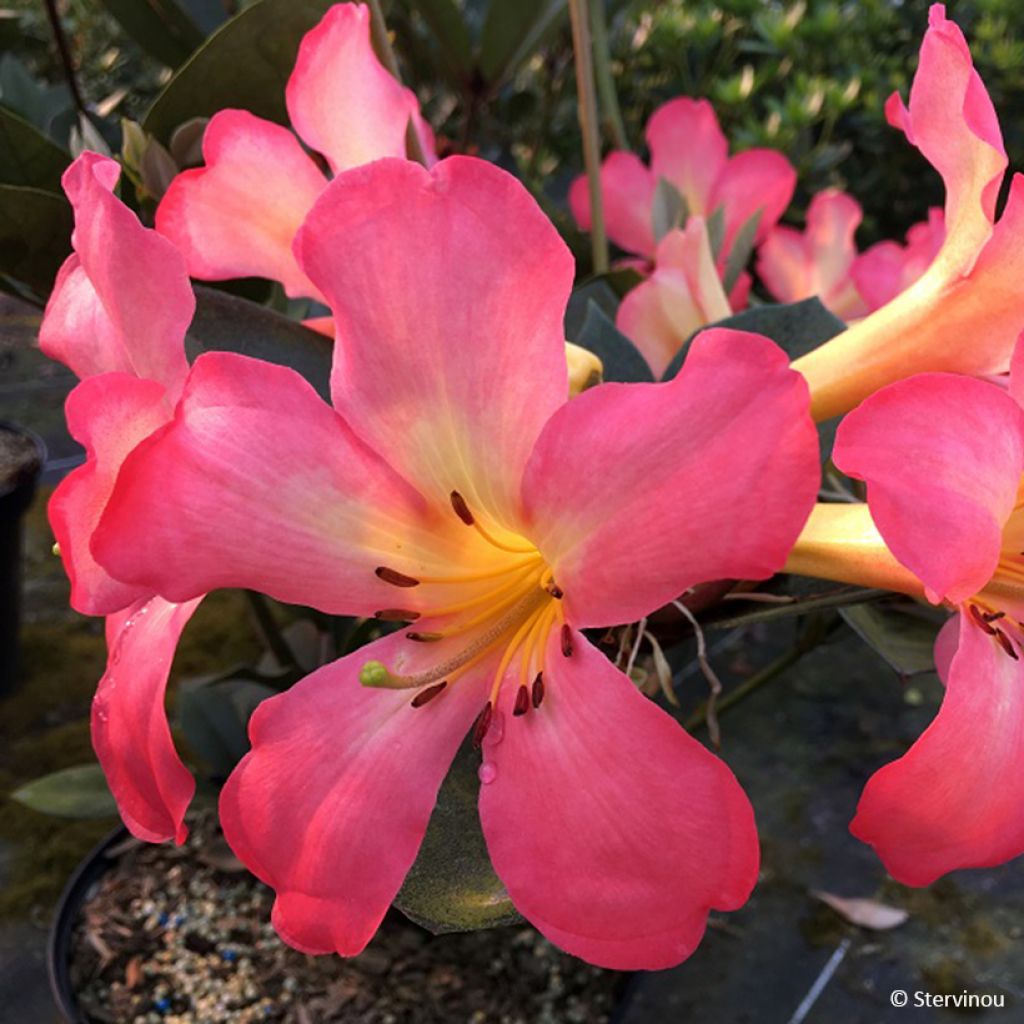

Rhododendron vireya Strawberry Parfait - Tropical Rhododendron
Rhododendron vireya Strawberry Parfait - Tropical Rhododendron
Rhododendron Strawberry Parfait
Tropical Rhododendron
Why not try an alternative variety in stock?
View all →This plant carries a 24 months recovery warranty
More information
We guarantee the quality of our plants for a full growing cycle, and will replace at our expense any plant that fails to recover under normal climatic and planting conditions.
From €5.90 for pickup delivery and €6.90 for home delivery
Express home delivery from €8.90.
Does this plant fit my garden?
Set up your Plantfit profile →
Description
Rhododendron 'Strawberry Parfait' is a rare medium-sized bush of tropical origin which can still withstand light frosts. Its evergreen vegetation consists of superb dark green foliage with a glossy surface. This dark background perfectly highlights the vibrant flowering of clusters of trumpet-shaped, bright pink flowers with a yellow throat. The flowers bloom for several months, mainly in spring. This variety should be grown in a container, in a well-draining acidic substrate, to be overwintered frost-free. It grows in not too bright sun, and light shading from taller plants will benefit it.
Rhododendron is a member of the Ericaceae family, which includes about a hundred often very ornamental genera, such as Kalmia, or Mountain Laurel, Leucothoe, and the charming Enkianthus. There are about 850 species of Rhododendron, which results in botanical classification into subgenera, sections, and subsections. The Vireya section (named after a French pharmacist, Julien-Joseph Virey, 1775-1846) includes 300 tropical species from Southeast Asia (Papua New Guinea, Indonesia, the Philippines...). They are often small and epiphytic (growing on trees, like many orchids in warm countries), while others are terrestrial, developing in the ground, like the hardy Rhododendrons we are more accustomed to.
'Strawberry Parfait' is a variety of Rhododendron armitii, a tropical species from the Vireya section (Solenovireya subsection), which in its natural habitat in Papua New Guinea forms a 2.50 m tall bush. It grows in mountainous areas at medium altitude (2400 to 2700 m), producing clusters of 5 to 7 white tubular flowers with a pink throat and fragrance. 'Strawberry Parfait' forms, under optimal conditions, a 2 m tall bush by 1.50 m wide. In our climates, it will be slightly smaller, which is actually an advantage for easy container gardening. It has elliptical leaves with pointed tips, measuring up to 7-8 cm long and 4-5 cm wide. This foliage is very dark green, and the surface of the leaf blades is glossy, giving the plant a constant ornamental appeal as it is evergreen.
The flowers are grouped in clusters of 5 to 7 units, at the ends of the branches. They have a trumpet shape, with the base formed by the fusion of the petals into a tube (the flowers are said to be gamopetalous, which is a characteristic of the Ericaceae family). Carried by floral peduncles about 2 cm long, they measure 5 to 6 cm long and the same width. The petals are not fused opposite the peduncle and open widely, exposing their beautiful pink colour, more or less vivid. The corolla's centre is yellow, as is the outer wall of the throat, creating a vibrant contrast. In our climates, flowering mainly occurs in spring, for a long duration, but this can vary, a remnant of the plant's tropical origins. In its native regions, flowering occurs for a good part of the year, with multiple flushes. Similarly, the intensity of the fragrance seems to vary among individuals.
Rhododendron 'Strawberry Parfait' should be grown in a container, as even though it can tolerate brief and mild frosts, it remains a tropical plant that appreciates warmth and humidity. This will allow you to provide it with a suitable acidic substrate even if your garden is not. Pair it with orangery plants to create an exotic decor. Cestrum nocturnum or Night-blooming Jasmine, will be a perfect companion. This shrub for mild climates, which you can also grow in a pot, is remarkable for its incredibly fragrant summer flowers. The Buddha's Hand (Citrus medica var. sarcodactylis) is a Citrus tree with fruits recognisable among a thousand. Stretched out in multiple long yellow fingers, these fruits exert a real fascination with their strangeness. And to add an architectural and colourful note to your scene, go for Clianthus puniceus 'Flamingo', an evergreen shrub with curious salmon flowers that have earned it the nickname "lobster claw" due to their very particular morphology. Its highly dissected evergreen foliage is almost as ornamental as its atypical flowers.
Report an error about the product description
Plant habit
Flowering
Foliage
Botanical data
Rhododendron
Strawberry Parfait
Ericaceae
Tropical Rhododendron
Cultivar or hybrid
Other Small Rhododendron
Planting and care
Rhododendron 'Strawberry Parfait' is a tropical variety that can only tolerate brief and light frosts, around -4°C. It should be grown in a pot to be protected from frost during winter. Plant it in a pot with a diameter of about thirty centimetres to start with, and after a few years, repot it in a slightly larger container. Use an acidic planting soil (pH 5 to 6) that is well-draining, and optionally add a layer of non-calcareous gravel at the bottom. You can also mix coarse perlite with the soil. Make sure the substrate remains moist, but not excessively, so as to avoid root rot.
Choose a semi-shaded location, under plants that can maintain a certain level of air humidity through their evapotranspiration. Avoid windy and drying areas, and in hot periods, mist around the plant from time to time. However, this plant enjoys light and can tolerate morning sun without any issues. Regularly remove faded flowers to extend the flowering period. Although the plant can tolerate light frosts, it is preferable to bring it indoors before winter to protect it.
Rhododendron vireya varieties are quite resistant to diseases (as long as good drainage is ensured to avoid water stagnation in the pot) and are not heavily attacked by insects. Nevertheless, inspect the foliage from time to time to ensure it is healthy.
Planting period
Intended location
Care
This item has not been reviewed yet - be the first to leave a review about it.
Evergreen shrubs
Haven't found what you were looking for?
Hardiness is the lowest winter temperature a plant can endure without suffering serious damage or even dying. However, hardiness is affected by location (a sheltered area, such as a patio), protection (winter cover) and soil type (hardiness is improved by well-drained soil).

Photo Sharing Terms & Conditions
In order to encourage gardeners to interact and share their experiences, Promesse de fleurs offers various media enabling content to be uploaded onto its Site - in particular via the ‘Photo sharing’ module.
The User agrees to refrain from:
- Posting any content that is illegal, prejudicial, insulting, racist, inciteful to hatred, revisionist, contrary to public decency, that infringes on privacy or on the privacy rights of third parties, in particular the publicity rights of persons and goods, intellectual property rights, or the right to privacy.
- Submitting content on behalf of a third party;
- Impersonate the identity of a third party and/or publish any personal information about a third party;
In general, the User undertakes to refrain from any unethical behaviour.
All Content (in particular text, comments, files, images, photos, videos, creative works, etc.), which may be subject to property or intellectual property rights, image or other private rights, shall remain the property of the User, subject to the limited rights granted by the terms of the licence granted by Promesse de fleurs as stated below. Users are at liberty to publish or not to publish such Content on the Site, notably via the ‘Photo Sharing’ facility, and accept that this Content shall be made public and freely accessible, notably on the Internet.
Users further acknowledge, undertake to have ,and guarantee that they hold all necessary rights and permissions to publish such material on the Site, in particular with regard to the legislation in force pertaining to any privacy, property, intellectual property, image, or contractual rights, or rights of any other nature. By publishing such Content on the Site, Users acknowledge accepting full liability as publishers of the Content within the meaning of the law, and grant Promesse de fleurs, free of charge, an inclusive, worldwide licence for the said Content for the entire duration of its publication, including all reproduction, representation, up/downloading, displaying, performing, transmission, and storage rights.
Users also grant permission for their name to be linked to the Content and accept that this link may not always be made available.
By engaging in posting material, Users consent to their Content becoming automatically accessible on the Internet, in particular on other sites and/or blogs and/or web pages of the Promesse de fleurs site, including in particular social pages and the Promesse de fleurs catalogue.
Users may secure the removal of entrusted content free of charge by issuing a simple request via our contact form.
The flowering period indicated on our website applies to countries and regions located in USDA zone 8 (France, the United Kingdom, Ireland, the Netherlands, etc.)
It will vary according to where you live:
- In zones 9 to 10 (Italy, Spain, Greece, etc.), flowering will occur about 2 to 4 weeks earlier.
- In zones 6 to 7 (Germany, Poland, Slovenia, and lower mountainous regions), flowering will be delayed by 2 to 3 weeks.
- In zone 5 (Central Europe, Scandinavia), blooming will be delayed by 3 to 5 weeks.
In temperate climates, pruning of spring-flowering shrubs (forsythia, spireas, etc.) should be done just after flowering.
Pruning of summer-flowering shrubs (Indian Lilac, Perovskia, etc.) can be done in winter or spring.
In cold regions as well as with frost-sensitive plants, avoid pruning too early when severe frosts may still occur.
The planting period indicated on our website applies to countries and regions located in USDA zone 8 (France, United Kingdom, Ireland, Netherlands).
It will vary according to where you live:
- In Mediterranean zones (Marseille, Madrid, Milan, etc.), autumn and winter are the best planting periods.
- In continental zones (Strasbourg, Munich, Vienna, etc.), delay planting by 2 to 3 weeks in spring and bring it forward by 2 to 4 weeks in autumn.
- In mountainous regions (the Alps, Pyrenees, Carpathians, etc.), it is best to plant in late spring (May-June) or late summer (August-September).
The harvesting period indicated on our website applies to countries and regions in USDA zone 8 (France, England, Ireland, the Netherlands).
In colder areas (Scandinavia, Poland, Austria...) fruit and vegetable harvests are likely to be delayed by 3-4 weeks.
In warmer areas (Italy, Spain, Greece, etc.), harvesting will probably take place earlier, depending on weather conditions.
The sowing periods indicated on our website apply to countries and regions within USDA Zone 8 (France, UK, Ireland, Netherlands).
In colder areas (Scandinavia, Poland, Austria...), delay any outdoor sowing by 3-4 weeks, or sow under glass.
In warmer climes (Italy, Spain, Greece, etc.), bring outdoor sowing forward by a few weeks.

































